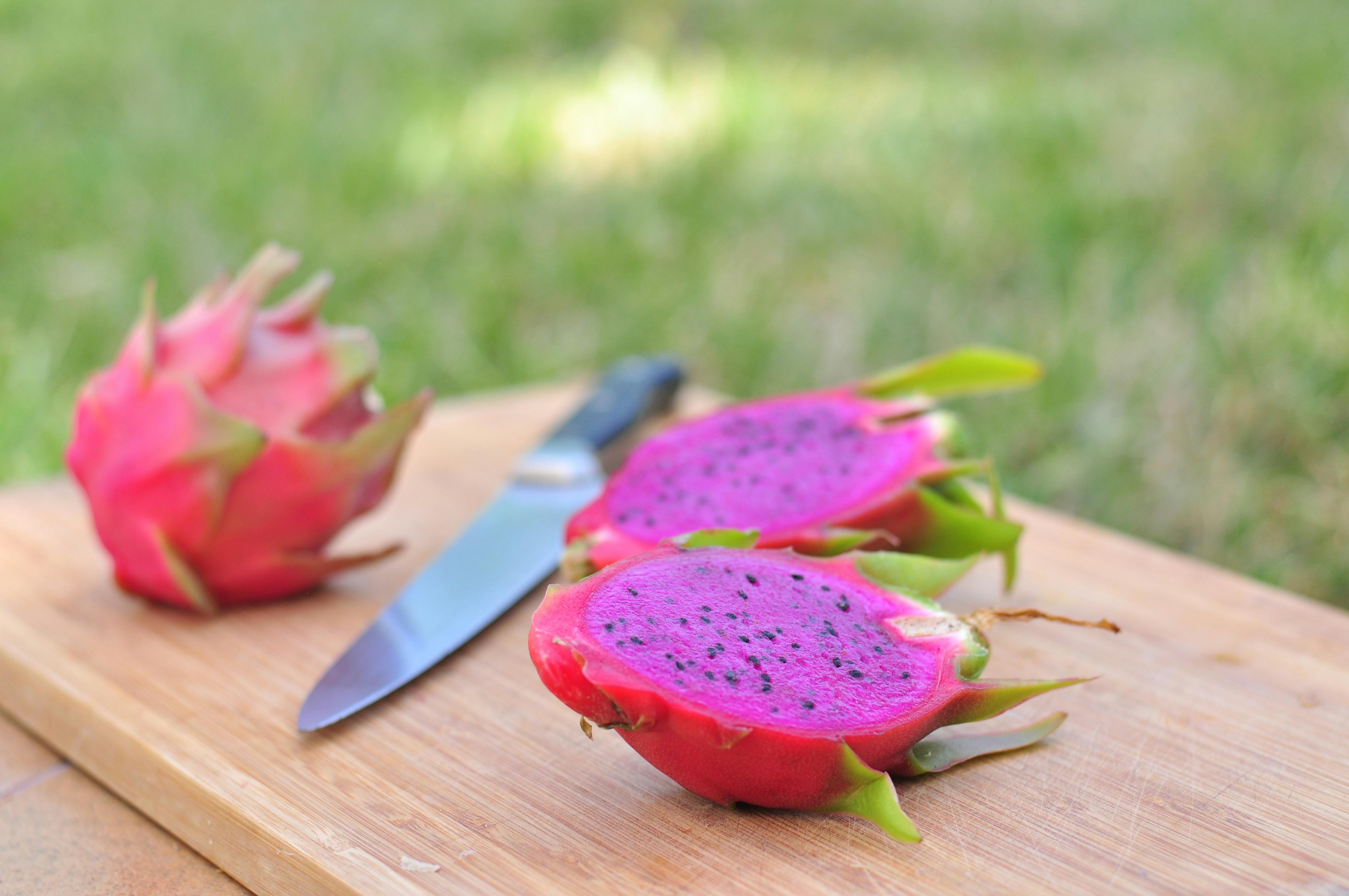Signs Of A Spoiled Dragon Fruit
Dragon fruit is a tropical fruit that is native to Central and South America. It has a unique flavor and texture, and can be enjoyed fresh or cooked. However, if it’s not stored properly, it can spoil quickly. Knowing the signs of a spoiled dragon fruit can help you avoid wasting money on a bad batch. Here are some signs to look for when checking for spoilage:The first sign of spoilage is the smell. Dragon fruit should have a sweet, pleasant aroma. If it smells sour or off, it’s likely spoiled. Another way to tell if dragon fruit has gone bad is the color. If the skin has become dull or discolored, it’s probably gone bad. You should also check for any soft spots on the surface of the fruit; this indicates that the dragon fruit is past its prime.
Texture is another indicator of spoilage in dragon fruit. Fresh dragon fruit should be firm and slightly spongy when squeezed gently. If it feels soft or mushy, it means that the dragon fruit has started to break down and should not be eaten. Lastly, if your dragon fruit has any mold growing on its surface, discard it immediately as this indicates advanced levels of spoilage.
Knowing how to identify spoiled dragon fruit can help you ensure that your fruits are always fresh and delicious!
Inspecting The Skin And Flesh Of Dragon Fruit
Dragon fruit, also known as pitaya, is a tropical fruit that has an impressive range of health benefits. It is native to Central and South America, and its popularity is steadily growing in many parts of the world. Before consuming dragon fruit, it is important to inspect the skin and flesh of the fruit for quality and freshness.The skin of dragon fruit can vary in color from yellow to pinkish-red and can be either smooth or scaly. The most common variety has a bright magenta skin with green scales. When inspecting the skin, look for any signs of cuts or bruises, which could indicate that the fruit is not fresh. The freshest dragon fruits will have vibrant colors and their scales will be intact.The flesh of dragon fruit comes in either white or magenta-colored varieties. When inspecting the flesh, look for any signs of discoloration or bruising which could indicate that it is not fresh. The freshest dragon fruits will have vibrant colors with no signs of discoloration on the surface. Additionally, there should be no unpleasant smells coming from the inside of the fruit.Dragon fruits are best consumed when they are fully ripe as this is when they offer the most health benefits and peak flavor. To check if a dragon fruit is ripe, gently press your thumb against its skin – it should give slightly but still remain firm. If it feels soft or mushy then it has likely over-ripened and should not be consumed as it won’t taste as good or provide as many health benefits.When choosing a dragon fruit at the store, take your time to inspect its skin and flesh carefully before purchasing it to ensure you get one that will taste delicious and provide you with all its nutritional benefits!
Unsuitable Storage Temperature
Dragon fruit is a tropical fruit and needs to be stored in a cool environment. If the temperature is too high or too low, the dragon fruit can quickly go bad. When storing dragon fruit, it’s best to keep it in a refrigerator at around 55°F (13°C). Keeping it at room temperature for more than a day can cause the dragon fruit to spoil quickly.Exposure to Sunlight
Dragon fruit should be kept away from direct sunlight since this can cause it to spoil more quickly. Prolonged exposure to sunlight can cause the dragon fruit’s skin to become wrinkled and discolored, and its flesh to become mushy and sour-tasting. It’s best to store dragon fruit in a dark, cool place such as the refrigerator if not being eaten immediately.Incorrect Ripening Process
Dragon fruit should be allowed to ripen on its own, rather than being forced. If the ripening process is sped up by putting it in a plastic bag or near other fruits that release ethylene gas, then the dragon fruit may become overripe too quickly and spoil before you can enjoy it. It’s best to leave dragon fruit out on the countertop until it is ripe enough for eating.Improperly Cleaned Skin
The skin of dragonfruit should be cleaned properly before cutting into it. If food particles are left on the skin or if dirt accumulates while storing, this could lead to bacteria growth which could cause your dragonfruit to spoil quickly. To avoid this problem, make sure you clean your dragonfruit thoroughly before cutting into it.Premature Picking
Dragonfruit should only be picked when they are ripe enough for consumption. If you pick them too early they will not have had time to develop their full flavor and sweetness, and they will not last as long either. It’s best to wait until they are fully ripe before picking them so that you can enjoy them at their peak flavor and freshness..Smelling The Dragon Fruit
Dragon fruit, also known as pitaya, is a tropical fruit that is native to Mexico and Central America. It is an exotic, sweet-tasting fruit with an intense aroma that has become increasingly popular in recent years. Dragon fruit has a unique shape and color, making it an attractive addition to any dish or smoothie. The taste of dragon fruit can vary from sweet to slightly tart, depending on the variety. Its unique flavor comes from its fleshy texture and high concentrations of antioxidants.The smell of dragon fruit can also be quite distinct. It has a slightly musky scent that can be described as having earthy notes with hints of sweetness. When cut open, dragon fruit emits a powerful scent that many people find pleasant and inviting. The smell of the dragon fruit can be enhanced by adding some fresh herbs or spices to it before serving.Dragon fruit is packed with vitamins and minerals that make it highly nutritious and beneficial for your health. It contains high levels of Vitamin C, iron, calcium, magnesium, potassium, zinc, and dietary fiber. These vitamins and minerals help boost the immune system and provide antioxidants that protect against disease-causing free radicals in the body.Dragon fruit is also low in calories and fat but high in fiber which helps fill you up quickly without consuming too many calories. Eating dragon fruit regularly can help improve digestion due to its high fiber content as well as help lower cholesterol levels thanks to its monounsaturated fats content.Overall, dragon fruit is a unique-looking exotic fruit with a powerful aroma that can make any dish or smoothie even more special! Its sweet taste combined with its nutritional benefits make it one of the healthiest fruits you can eat!
Examining The Color Of Dragon Fruit
Dragon fruit is a unique and vibrant tropical fruit. It is known for its distinct look and colorful skin. The color of dragon fruit can range from bright pink to yellow and even purple. Some varieties have a combination of colors, too. Dragon fruit is also covered in small, spiky scales that give it a unique texture.Dragon fruit gets its color from the antioxidants present in the peel of the fruit. These antioxidants, like carotenoids and flavonoids, give the dragon fruit its vibrant hue. These antioxidants are also beneficial to our health as they help protect against cell damage caused by free radicals in the body. Additionally, dragon fruit is rich in vitamins A and C, which provide further health benefits when eaten.The color of dragon fruit also depends on where it is grown and how it is harvested. For example, in more temperate climates such as Southeast Asia or South America, dragon fruit will be brighter in color due to the higher levels of light available for photosynthesis. Similarly, dragon fruits grown in cooler climates may be paler due to less sunlight exposure during growth and harvest time.When looking for dragon fruits at the store or market, look for those with bright colors as these generally indicate higher levels of antioxidants and vitamins present in the fleshy pulp inside the outer rind. Avoid buying fruits that are pale or dull-looking as these may not have been ripened properly or are past their prime for eating fresh.Overall, examining the color of dragon fruits should be done carefully when selecting them for purchase or consumption. The vibrant hues indicate an abundance of beneficial vitamins and antioxidants, so make sure to choose those with brighter colors when possible!Taste Testing The Dragon Fruit
Dragon fruit, also known as pitaya, is a sweet and exotic fruit that is becoming increasingly popular. It has a unique flavor and texture that is unlike any other fruit. It is often used in smoothies, desserts, and even salads. But how does it taste? That’s what we’re here to find out!Taste testing dragon fruit can be a fun and delicious experience. The flavor of dragon fruit varies depending on the variety, but generally it has a sweet taste with hints of citrus or berry. The texture is soft and juicy, similar to that of a kiwi or mango. It can be eaten raw or cooked into dishes such as pies, jams, and sauces.
The flesh of the dragon fruit can be creamy white or pink in color. Depending on the variety, it may have small black seeds throughout the flesh or none at all. The skin of the dragon fruit can range from yellow to bright pink in color and may have spines or scales like those found on other cactus fruits.
When taste testing dragon fruit, there are several things to keep in mind. First, make sure to take your time when eating it so you can get the full flavor experience. Second, use your senses! Look at its vibrant colors before you take a bite and smell its sweet aroma as you eat it.
Finally, don’t forget to savor every bite! Dragon fruit has a unique flavor that you won’t find in any other type of fruit. Once you’ve tried it for yourself, you’ll understand why so many people love this exotic treat!
Is Red Dragon Fruit Bad If It’s Ripe and Laxative Properties Are Present?
Ripe red dragon fruit is not bad for you; in fact, its natural fibers and nutrients can support digestive health. Many wonder, “can red dragon fruit aid digestion?” The fruit contains antioxidants and prebiotics, which can promote gut health and improve digestion when consumed in moderation. Enjoy it as part of a balanced diet.
How To Store Dragon Fruit Properly
Dragon fruit, also known as pitaya, is a tropical fruit that can be found in many parts of the world. It has a sweet yet mild taste and a unique texture. Dragon fruit can be eaten fresh or used in a variety of dishes. Storing dragon fruit properly is essential to ensure it stays fresh and flavorful for longer. Here are some tips on how to store dragon fruit properly:When buying dragon fruit, look for those that are firm and have bright-colored skin. Avoid those with any bruises or blemishes on the skin. Once you get home, store the dragon fruit in the refrigerator where it will stay fresh for up to five days. If you won’t be able to eat the dragon fruit within five days, you can also freeze it for up to three months.
If you plan on eating the dragon fruit within two days, store it at room temperature in a cool and dry place away from direct sunlight. However, if you leave it out for more than two days, store it in the refrigerator so that it does not spoil. When storing frozen dragon fruit, make sure to wrap it tightly and keep it away from any strong odors as this can affect its flavor.
When cutting dragon fruit, make sure to use kitchen gloves since its juice can stain your hands and clothes. Slice the flesh into cubes or slices depending on how you plan on using it. Place the cut pieces in an airtight container lined with paper towels before storing them in either the refrigerator or freezer. This will help keep them fresher for longer periods of time.
By following these tips on how to store dragon fruit properly, you can enjoy this delicious tropical treat for longer periods of time!

Conclusion
Overall, it is important to pay attention to the signs that a dragon fruit is bad. These signs include a strange smell, mold, and soft spots. If you see any of these signs, you should discard the fruit immediately. Be sure to inspect dragon fruits carefully before consuming them. Additionally, store dragon fruits in a cool and dry place to ensure optimal freshness. With proper storage and inspection, you can ensure that the dragon fruit you consume is fresh and delicious.Dragon fruits are an interesting and unique tropical fruit with a sweet flavor and juicy texture. They can be enjoyed in a variety of ways including blended into smoothies or added to salads. By familiarizing yourself with the signs of a bad dragon fruit and proper storage techniques, you can enjoy this nutritious fruit with confidence.



